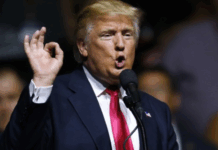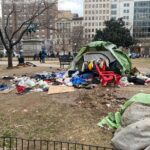
In a bold and controversial shift, the White House has laid down a stark ultimatum for those living in homeless encampments across Washington, D.C.: Get help—or go to jail.
That’s the message delivered by Press Secretary Karoline Leavitt during a tense Tuesday briefing, as questions mounted about President Donald Trump’s dramatic federal intervention in the capital’s crumbling public safety and urban order.
This move is not just a policy decision—it’s a declaration. Trump’s administration is making it clear: The era of lawlessness and unchecked decay in the capital is over. According to Leavitt, 70 encampments have already been dismantled by the U.S. Park Police, and only two remain in areas under the National Park Service’s jurisdiction—both scheduled for imminent removal. The Metropolitan Police Department will now join the effort, signaling a full-throttle approach.
Reporters asked what would become of the homeless who refuse to vacate. Leavitt didn’t mince words: “Homeless shelters, for addiction and mental health services, or jail if they refuse, are the options on the table right now.”
This is a dramatic break from the hesitant, often hands-off policies of previous administrations. For years, D.C. has struggled with the growing visibility of its homeless population, especially in parks, near federal buildings, and in the heart of downtown. Critics argued that inaction and permissiveness only deepened the crisis. The Trump White House has clearly heard enough.
Trump has even floated a longer-term solution: relocating homeless individuals out of the city entirely. While that idea remains in the exploratory phase, the administration has already begun reshaping the landscape. Fox News Digital, touring former homeless hotspots, found little more than debris—clothing, food wrappers, and signs of recent habitation—marking where encampments once stood.
Yet elsewhere, the issue persists. Tents remain in parks. People still sleep under overpasses and gather in groups along sidewalks—some seemingly unaware that enforcement is on its way. In one area, a dried red stain marked the pavement outside a camp, a haunting reminder of the instability this crisis has brought.
The crackdown comes in the wake of rising violent crime, including attacks on federal workers. One of the most high-profile incidents was the brutal beating of Edward Coristine, a former Department of Government Efficiency staffer and social media figure. Trump invoked the case by name, calling Coristine a “beautiful, handsome guy that got the hell knocked out of him,” emblematic of the broader crisis gripping the capital.
Trump, never one to temper language, described D.C. as “one of the most dangerous cities anywhere in the world,” blaming gangs and “young thugs” for a wave of random attacks, muggings, and shootings. His administration’s posture is unambiguous: this is a federal emergency, and the time for half-measures is over.








